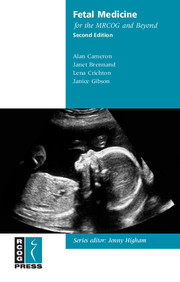Book contents
- Frontmatter
- Contents
- Preface
- Abbreviations
- 1 Screening for chromosomal abnormalities
- 2 Prenatal diagnostic techniques
- 3 The routine anomaly scan
- 4 Fetal structural abnormalities
- 5 Fetal therapy
- 6 Prenatal diagnosis and management of non-immune hydrops fetalis
- 7 Termination of pregnancy for fetal abnormality
- 8 Fetal growth restriction
- 9 Twin pregnancy
- 10 Fetal infection
- Index
5 - Fetal therapy
Published online by Cambridge University Press: 05 August 2014
- Frontmatter
- Contents
- Preface
- Abbreviations
- 1 Screening for chromosomal abnormalities
- 2 Prenatal diagnostic techniques
- 3 The routine anomaly scan
- 4 Fetal structural abnormalities
- 5 Fetal therapy
- 6 Prenatal diagnosis and management of non-immune hydrops fetalis
- 7 Termination of pregnancy for fetal abnormality
- 8 Fetal growth restriction
- 9 Twin pregnancy
- 10 Fetal infection
- Index
Summary
Historical aspects
Treatment of the fetus in utero has been a possibility for obstetricians since the 1960s. This was a time when the dawn of a new branch of medicine, perinatal medicine, became a reality through the contributions of obstetricians such as Professor Ian Donald in Glasgow and Dr AW Liley in New Zealand. Their research on the development of ultrasound and amniocentesis in rhesus sensitisation enabled doctors to treat the fetus as a patient. Since then, other milestones in the creation of this branch of medicine have been Professor GC Liggins' work in the 1970s on the maternal administration of corticosteroids to prevent respiratory distress syndrome and the practical and laboratory genetic techniques for prenatal diagnosis in the first trimester of pregnancy throughout the 1980s.
The key to the success of attempts at fetal diagnosis and therapy has been the continued improvement in fetal imaging techniques, mainly with high-resolution ultrasound techniques and the use of ultrafast magnetic resonance imaging. In the future, rapid progress is likely to be made in real time three-dimensional ultrasound procedures and, together with advances in minimal-access surgical techniques, the concept of providing true fetal treatment is a real possibility in the years ahead.
The main clinical areas of focus as regards potential fetal therapy have been prematurity, fetal growth restriction, fetal malformations and specific genetic conditions. The main types of fetal therapy that were introduced include preventive therapy, transplacental treatment, perinatal management of the fetus with a malformation and invasive fetal procedures.
- Type
- Chapter
- Information
- Fetal Medicine for the MRCOG and Beyond , pp. 79 - 114Publisher: Cambridge University PressPrint publication year: 2011

